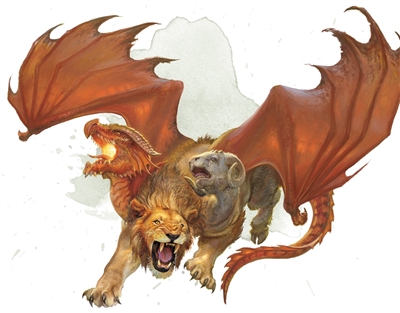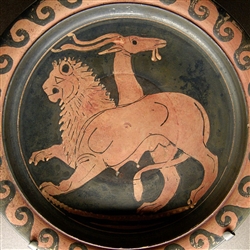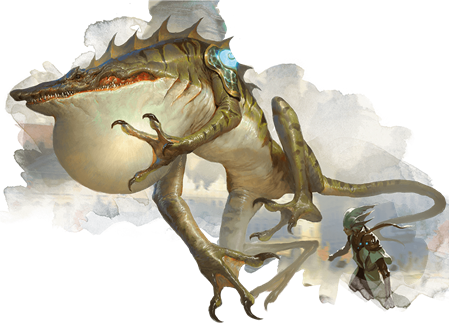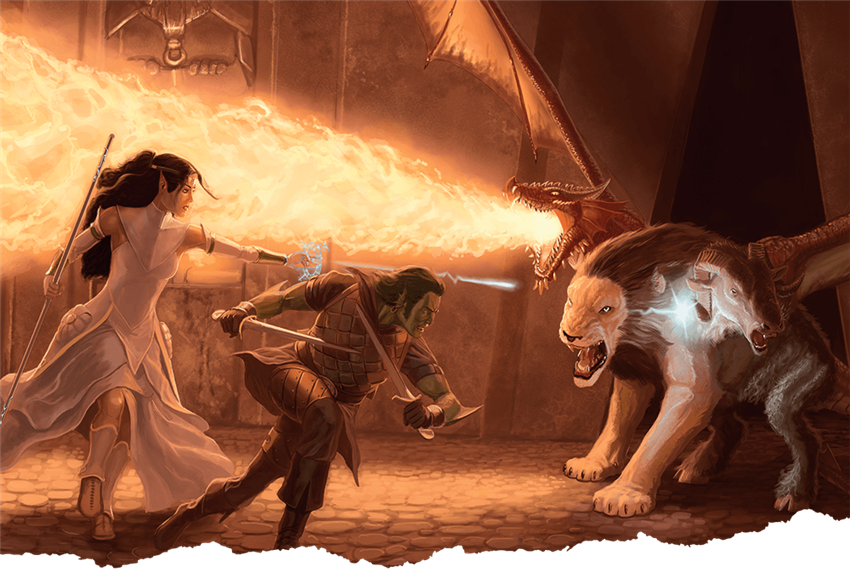“Iobates ordered [Bellerophon] to kill the Chimera, believing that he would be destroyed by the beast, for it was more than a match for many, let alone one; it had the fore part of a lion, the tail of a dragon, and its third head, the middle one, was that of a goat, through which it belched fire. And it devastated the country and harried the cattle; for it was a single creature with the power of three beasts.”
—Bibliotheca of Pseudo-Apollodorus, translated by Sir James George Frazer
 Few creatures of Greek mythology are more famous than the dreaded Chimera, which was killed by the hero Bellerophon with the aid of the winged horse, Pegasus. The Chimera, which Homer described in The Illiad as a creation of immortal make, with the front of a lion, the middle of a goat, and a tail made from a venomous snake (translated by A.T. Murray). Though the chimera found in the D&D Monster Manual is also three-headed, it is somewhat different from the chimera of myth.
Few creatures of Greek mythology are more famous than the dreaded Chimera, which was killed by the hero Bellerophon with the aid of the winged horse, Pegasus. The Chimera, which Homer described in The Illiad as a creation of immortal make, with the front of a lion, the middle of a goat, and a tail made from a venomous snake (translated by A.T. Murray). Though the chimera found in the D&D Monster Manual is also three-headed, it is somewhat different from the chimera of myth.
Like most D&D monsters lifted from Greek mythology, the chimera of D&D isn’t one-of-a-kind, but part of a species of similar monsters. It has three heads, that of a lion, a goat, and a red dragon, and is lion-fronted, dragon-winged, and goat-backed. It breathes fire from its dragon head, though in Greek myth, it was the goat head from which fire spewed. Even within the Hellenic world, however, the specific vision of the Chimera was inconsistent. Homer’s earliest extant account of the Chimera described it in snake-tailed form, whereas Pseudo-Apollodorus’s Bibliotheca described the chimera as being part-dragon, instead. In modern times, a chimera can refer to any monster amalgamated from different creatures, such as the human-animal hybrid chimeras of Fullmetal Alchemist, the winged, two-headed, two-tailed chimaeras of World of Warcraft, and so on.
How can you create chimeras to suit your needs as a Dungeon Master?
Creating a Rainbow of Draconic Chimeras
Of note, in some previous editions of Dungeons and Dragons, the chimera could have the head of any sort of chromatic dragon, not just a red dragon. If you want to give a chimera a different dragon head in fifth edition, there are two things you need to do: change the breath’s damage type, and possibly change its shape. If the dragon head is green, red, or white, the area of the breath weapon is a 15-foot cone. If the dragon head is black or blue, the area of the breath weapon is a 25-foot line.
Creating a Hellenic Chimera
 Just like tweaking the draconic head of the D&D chimera, it’s a simple task to create a chimera based on the original monster of Hellenic legend. Changing its three heads to be that of a lion, a goat, and a serpent is a simple task; all you need to do is remove the dragon head and the chimera’s draconic wings. In exchange for the loss of its wings, give the chimera a fourth attack as a part of its Multiattack action:
Just like tweaking the draconic head of the D&D chimera, it’s a simple task to create a chimera based on the original monster of Hellenic legend. Changing its three heads to be that of a lion, a goat, and a serpent is a simple task; all you need to do is remove the dragon head and the chimera’s draconic wings. In exchange for the loss of its wings, give the chimera a fourth attack as a part of its Multiattack action:
Multiattack. The chimera makes four attacks. One with its bite (lion’s head), one with its horns (goat’s head), one with its claws, and one with its fangs (serpent’s head). When its fire breath is available, it can use the breath in place of its horns.
Fangs. Melee Weapon Attack: +7 to hit, reach 10 ft., one target. Hit: 2 (1d4) piercing damage and the target must make a DC 15 Constitution saving throw, taking 27 (6d8) poison damage on a failed save, or half as much on a successful one.
The lack of flight hinders both the chimera’s offense and its defense, but its potent new attack ensures that the Hellenic Chimera is just as powerful as the D&D one. Just make sure it’s the goat’s head that’s breathing fire!
Creating a Chimera of Demogorgon
 In D&D, the first chimeras were created by the demon lord Demogorgon when he first entered the Material Plane and was unimpressed with the balance of nature. The Monster Manual describes the lion-goat-dragon chimera as a “typical specimen” of a chimera. This sits strangely with me. I like the idea of chimeras being the creations of a demon lord, as if a godlike entity picked up three critters and randomly smashed them together, like a child playing with a tub full of LEGOs. Maybe these “typical” chimeras are the only ones that breed true, or some other justification, but in my opinion, chimeras should be made up of all sorts of wild and wooly combinations.
In D&D, the first chimeras were created by the demon lord Demogorgon when he first entered the Material Plane and was unimpressed with the balance of nature. The Monster Manual describes the lion-goat-dragon chimera as a “typical specimen” of a chimera. This sits strangely with me. I like the idea of chimeras being the creations of a demon lord, as if a godlike entity picked up three critters and randomly smashed them together, like a child playing with a tub full of LEGOs. Maybe these “typical” chimeras are the only ones that breed true, or some other justification, but in my opinion, chimeras should be made up of all sorts of wild and wooly combinations.
Everyone has a different idea of what a chimera should be like. Think about what traits a chimera needs to have in order to be a chimera, and not just some wacky arcane abomination. Is an owlbear a chimera? What about a minotaur, or a manticore, or a sphinx? Is Frankenstein’s monster a chimera? Mary Shelley used the word “chimera” and “chimerical” to describe the creature on more than one occasion! A lot of mythological monsters were devised by mashing animals together or combining human and bestial traits to create something new. To me, a chimera needs these defining traits to be a chimera, and not just a monstrosity:
- Made up of different aberrations, beasts, dragons, monstrosities; most other monster types are unsuitable for chimera creation
- Made up of three different creatures that are not themselves hybrid creatures like owlbears
- Displays a defining characteristic of each creature
The only mechanical requirements that this list of traits presents is that your new chimera must have at least three mechanics that represent its component creatures. Personally, the chimera in the Monster Manual doesn’t do this very well. The dragon is overrepresented, with both wings and a breath weapon, and the lion and goat are only represented by generic claw and horns attacks. In fairness, the Hellenic Chimera gives the goat head the ability to breathe fire, so who knows?
The best way to create a chimera is to use the monster-creation math in the Dungeon Master’s Guide and create a new creature based on the chimera in the Monster Manual. Choose three creatures from any existing D&D monsters. For example, a giant toad, a giant octopus, and a giant wasp. The giant toad has the Amphibious and Standing Leap traits that make it fearsome on land, as well as Bite and Swallow actions. The giant octopus has tentacle attacks and a swimming speed, as well as the ability to spew an ink cloud—perhaps this ink cloud could also be toxic, filled with venom from the giant wasp. Speaking of, the wasp has a fearsome stinger which can deliver a paralytic poison. It also has wings, but this creature already has a lot going on, and giving flight to an aquatic creature just seems like overkill.
 How horrible! This aquatic chimera has a lot of nasty features. Offhand, how do these traits affect a creature’s challenge rating? Unfortunately, all of these traits we chose aren’t specifically listed on the “Monster Features” table in chapter 9 of the Dungeon Master’s Guide, but we’ll make do.
How horrible! This aquatic chimera has a lot of nasty features. Offhand, how do these traits affect a creature’s challenge rating? Unfortunately, all of these traits we chose aren’t specifically listed on the “Monster Features” table in chapter 9 of the Dungeon Master’s Guide, but we’ll make do.
When it comes to actually creating the beast, using the chimera stat block as a chassis is a good start. Use its ability scores, hit points, Armor Class, and so on, and just strip out the traits unique to its lion, goat, and dragon components. That means all of its attacks, its Fire Breath, and its flying speed, as well as its ability to understand Draconic. From here, add in your unique attacks and traits, such as Bite, Swallow, Tentacle, Ink Cloud, and Stinger. With Multiattack, you could allow this aquatic chimera to make three attacks per turn, like Bite, Tentacle, and Stinger. The synergy between Bite and Tentacle, both of which can grapple foes, is terrifying! Maybe these tentacles are more like long, spindly frog legs, and have claws that can grip creatures it grabs? If its Ink Cloud is active (I would make it recharge on a roll of 5–6, rather than being once per short or long rest), then it can replace its tentacle attack with the Ink Cloud action.
Make sure you’re using the baseline chimera’s ability scores and proficiency bonus (for CR 6 creatures, it’s +3) to determine the to-hit, damage, and saving throw DC values for this new monster. Once all that’s set, put those numbers back into the monster creation table in the Dungeon Master’s Guide and see what the final challenge rating of your chimera is. If you find that it’s too strong or too weak, now you can go back and tweak its numbers a little bit until you find the sweet spot.
This new chimera of Demogorgon that you’ve created is just one of many hideous, chimeric amalgamations created when Demogorgon first walked on the Material Plane. Use it wisely.

Chimera Tactics
Finally, no monster article would be complete without a look at its tactics. Today, I think the best tactical analysis has already been done; I encourage you to read Keith Ammann’s (@geeniusatwrok) breakdown of a chimera’s battle tactics on The Monsters Know What They’re Doing. Keep in mind that these tactics are best applied to a single chimera in mortal combat against a group of player characters. Altering the landscape of the battle by introducing multiple factions, or allies for the chimera, may change the optimal tactics.
When fighting in groups, note that chimeras aren’t intelligent, but they are cunning. This makes them excellent minions for draconic, half-dragon, kobold, lizardfolk or dragonborn villains. That is, villains who speak Draconic, the only language which chimeras understand. Chimeras are innately chaotic and cruel as a result of the horrible magic that birthed them; consider how you can show this in a group battle. If the characters are fighting against four dragonborn knights and their chimera pet, the knights would try to keep their distance from the characters, attacking from range, to avoid getting toasted by the chimera’s fire breath—since the creature probably wouldn’t even try to mitigate collateral damage in its attacks.
On the other hand, if these warriors are red dragonborn, and thus have fire resistance, they might wade through the flames despite the pain. If they’re particularly evil, they might hire a bunch of human mercenary thugs and not tell them about the chimera’s penchant for friendly fire. Then, you can set up a horrific scene where the thugs and the player characters both get toasted by the chimera’s fire breath.
Have you created your own chimera before? What creatures did you use to make it? Let us know in the comments!
 James Haeck is the lead writer for D&D Beyond, the co-author of Waterdeep: Dragon Heist and the Critical Role Tal'Dorei Campaign Setting, the DM of Worlds Apart, and a freelance writer for Wizards of the Coast, the D&D Adventurers League, and Kobold Press. He lives in Seattle, Washington with his partner Hannah and their animal companions Mei and Marzipan. You can find him wasting time on Twitter at @jamesjhaeck.
James Haeck is the lead writer for D&D Beyond, the co-author of Waterdeep: Dragon Heist and the Critical Role Tal'Dorei Campaign Setting, the DM of Worlds Apart, and a freelance writer for Wizards of the Coast, the D&D Adventurers League, and Kobold Press. He lives in Seattle, Washington with his partner Hannah and their animal companions Mei and Marzipan. You can find him wasting time on Twitter at @jamesjhaeck.








-
View User Profile
-
Send Message
Posted Jul 12, 2019To clarify it body structure look at the picture of the Couatl scale it two sizes larger, make it scales black, and give it a wyverns stinger.
-
View User Profile
-
Send Message
Posted Jul 12, 2019I also made this Giant Chimeric Insect. It's a bit lower on the challenge rating as I used the giant variations of crab, scorpion, and spider to create this chimera. But I think I did a decent job of creating this beastie... I wanted to create a chimera that wasn't immediately obvious of it being a chimera... even a thorough inspection of this monstrosity from a distance wouldn't display any obvious signs that it was anything but a giant scorpion. Unless you saw it coming from the water or shooting web, adventurers wouldn't have a clue they were dealing with such a versatile monster.
-
View User Profile
-
Send Message
Posted Jul 12, 2019Here is a chimera I made from a yeti, manticore and hook horror.
chimera (yeti, manticore, hook horror)
-
View User Profile
-
Send Message
Posted Jul 12, 2019Here is another chimera I made. This one makes a good familiar or pet.
Cacraba Chimera
-
View User Profile
-
Send Message
Posted Jul 12, 2019Another chimera.
Lighting Chimera
-
View User Profile
-
Send Message
Posted Jul 12, 2019I dont think it is based on Dragonborns breath attacks, more likely based off of what half of a older dragons breath of the various types would be, so 60ft line to 30ft, 50ft cone to 25ft. Just my guess though.
-
View User Profile
-
Send Message
Posted Jul 13, 2019Loved the article. Something about the mix and match creature suggestion reminded me about the Krasis creatures from Ravnica. One of which is CR 6.
-
View User Profile
-
Send Message
Posted Jul 13, 2019It sounds like your campaign will be a fun one! I might want to play it!
-
View User Profile
-
Send Message
Posted Jul 14, 2019I "created" a version of the chimera that existed in previous edition. The gorgimera. It's a chimera but the goat head is a Gorgon instead so add personification breath to the fire breath. Also, gorgimera can see in the ethereal plane.....somehow
-
View User Profile
-
Send Message
Posted Jul 16, 2019I'm currently running an Eberron campaign that has featured some rogue elements of House Vadalis as antagonists and Chimera's work really well for the types of creatures they would throw at my party.
-
View User Profile
-
Send Message
Posted Jul 19, 2019Love the shout out to TMKWTD. Great read for a DM of any experience level.
-
View User Profile
-
Send Message
Posted Jul 25, 2019I had an idea for a gargoyle-grick-nothic chimera... might not work.
-
View User Profile
-
Send Message
Posted Jul 25, 2019AAAAARRRGH! I keep trying to make a special Arctic chimera, but my work keeps getting deleted! It would have the notes of the young remorhaz and polar bear, the ice breath of the young white dragon, the white dragon’s burrowing, the remorhaz’s damage immunities, and the polar bear’s keen smell.
-
View User Profile
-
Send Message
Posted Aug 3, 2019Just an editing note, "amalgamation" is not a word, it's just "amalgam". That being said, I'm working on incorporating this into my next campaign, great article!
-
View User Profile
-
Send Message
Posted Aug 4, 2019Merriam-Webster, the dictionary which D&D and D&D Beyond house style refer to, lists amalgamation as a noun synonymous with amalgam (definition 2).
-
View User Profile
-
Send Message
Posted Aug 5, 2019I made a Winter Chimera by amalgamating a yeti, a giant crab, and a giant bat. Think it turned out great.
-
View User Profile
-
Send Message
Posted Aug 26, 2019Speaking of MTG, many Simic creations can be used as chimeras, as well as select few Gruul, Golgari, Izzet, and Rakdos critters. There are some MTG dinosaurs that work well too. If you are looking for some ideas and have access to GGR, try the Simic Krasis tables.
-
View User Profile
-
Send Message
Posted Jul 24, 2020They actually added this in with the Theran Chimeras.
You can customize chimeras in Mythic Odysseys Of Theros.
-
View User Profile
-
Send Message
Posted Jul 27, 2020I really like the custom chimera thing! Simic Krasis from Ravnica also work for a customizable hybrid monster.
-
View User Profile
-
Send Message
Posted Jul 27, 2020Didn’t see these. I agree!